The NVIDIA GeForce GTX Titan X Review
by Ryan Smith on March 17, 2015 3:00 PM ESTOverclocking
Finally, no review of a GTX Titan card would be complete without a look at overclocking performance.
From a design standpoint, GTX Titan X already ships close to its power limits. NVIDIA’s 250W TDP can only be raised another 10% – to 275W – meaning that in TDP limited scenarios there’s not much headroom to play with. On the other hand with the stock voltage being so low, in clockspeed limited scenarios there’s a lot of room for pushing the performance envelope through overvolting. And neither of these options addresses the most potent aspect of overclocking, which is pushing the entirely clockspeed curve higher at the same voltages by increasing the clockspeed offsets.
GTX 980 ended up being a very capable overclocker, and as we’ll see it’s much the same story for the GTX Titan X.
| GeForce GTX Titan X Overclocking | ||||
| Stock | Overclocked | |||
| Core Clock | 1002MHz | 1202MHz | ||
| Boost Clock | 1076Mhz | 1276MHz | ||
| Max Boost Clock | 1215MHz | 1452MHz | ||
| Memory Clock | 7GHz | 7.8GHz | ||
| Max Voltage | 1.162v | 1.218v | ||
Even when packing 8B transistors into a 601mm2, the GM200 GPU backing the GTX Titan X continues to offer the same kind of excellent overclocking headroom that we’ve come to see from the other Maxwell GPUs. Overall we have been able to increase our GPU clockspeed by 200MHz (20%) and the memory clockspeed by 800MHz (11%). At its peak this leads to the GTX Titan X pushing a maximum boost clock of 1.45GHz, and while TDP restrictions mean it can’t sustain this under most workloads, it’s still an impressive outcome for overclocking such a large GPU.
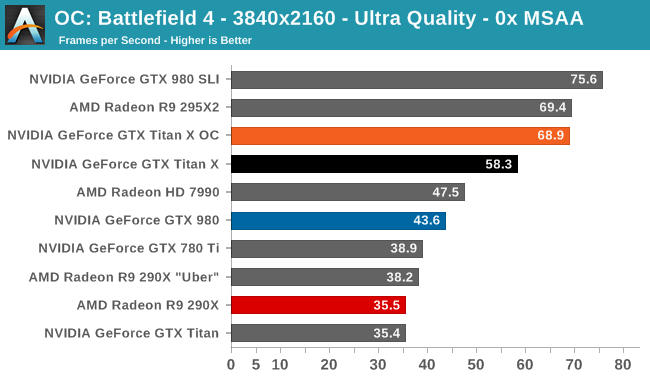
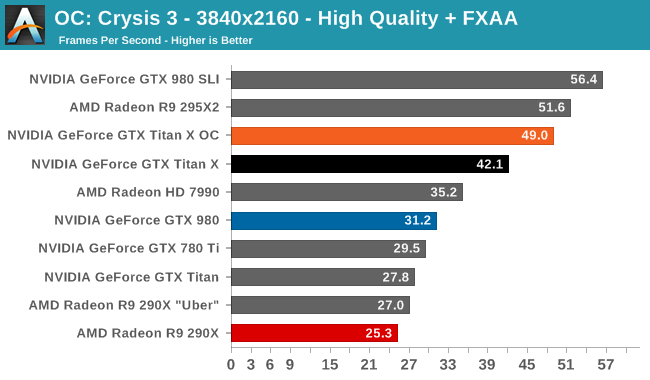
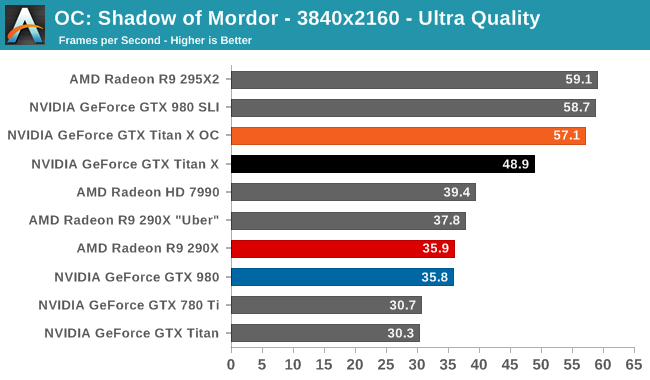
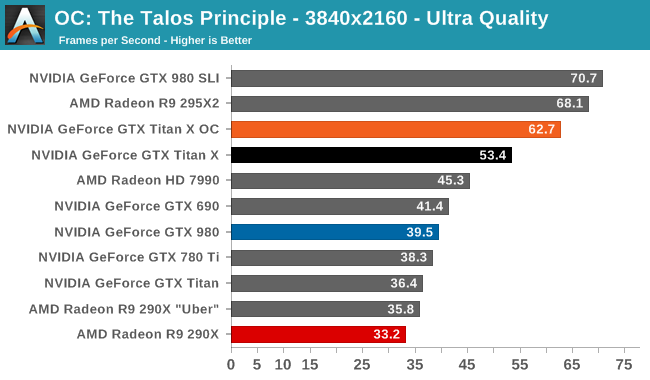
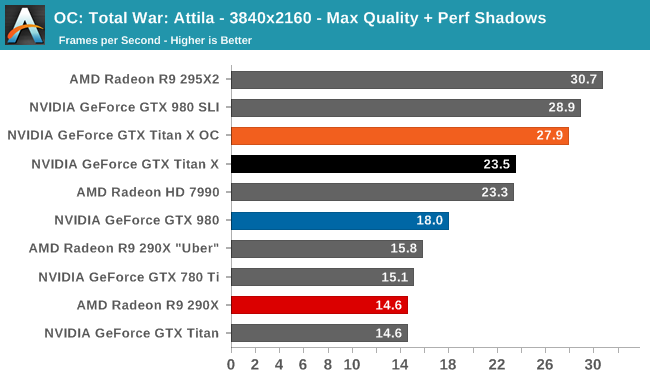
The performance gains from this overclock are a very consistent 16-19% across all 5 of our sample games at 4K, indicating that we're almost entirely GPU-bound as opposed to memory-bound. Though not quite enough to push the GTX Titan X above 60fps in Shadow of Mordor or Crysis 3, this puts it even closer than the GTX Titan X was at stock. Meanwhile we do crack 60fps on Battlefield 4 and The Talos Principle.
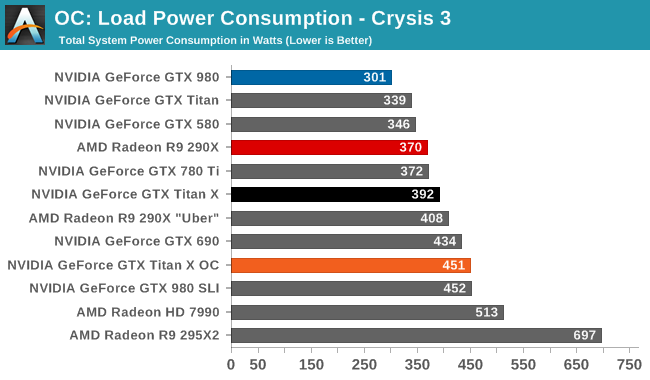
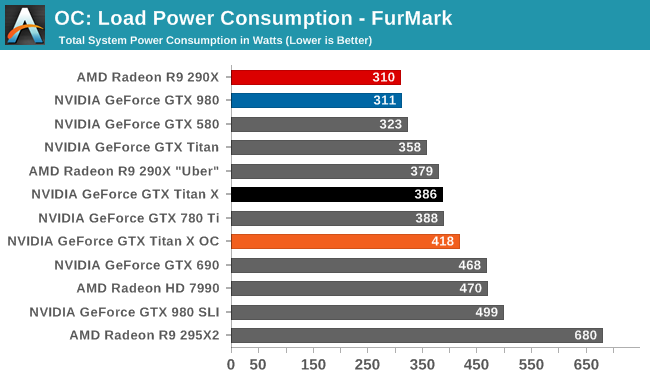
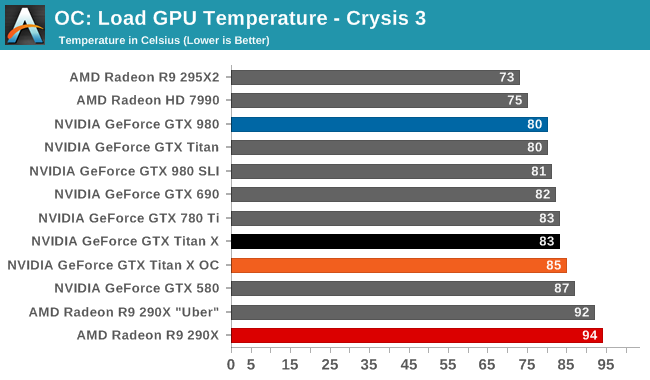
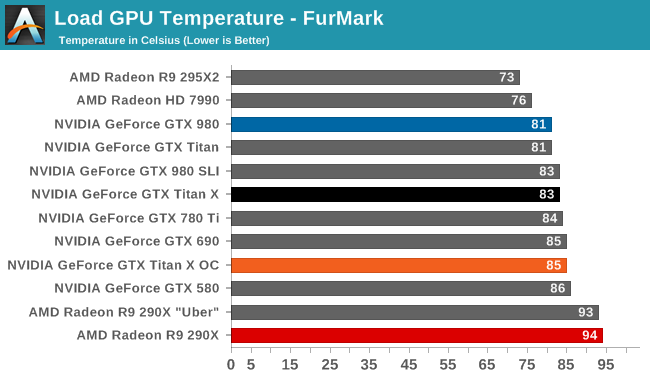


The tradeoff for this overclock is of course power and noise, both of which see significant increases. In fact the jump in power consumption with Crysis is a bit unexpected – further research shows that the GTX Titan X shifts from being temperature limited to TDP limited as a result of our overclocking efforts – while FurMark is in-line with the 25W increase in TDP. The 55dB noise levels that result, though not extreme, also mean that GTX Titan X is drifting farther away from being a quiet card. Ultimately it’s a pretty straightforward tradeoff for a further 16%+ increase in performance, but a tradeoff nonetheless.










276 Comments
View All Comments
joeh4384 - Tuesday, March 17, 2015 - link
Old news.joeh4384 - Tuesday, March 17, 2015 - link
I bet if you overclock the crap out of this, its TDP shoots north of 300 watts.cmdrdredd - Tuesday, March 17, 2015 - link
People buying this don't care about TDP.Kutark - Tuesday, March 17, 2015 - link
Which means even with OC it would still be at or under a 290x. I'm failing to see the problem here.TDP is really only super important for compute cards that will be running for hours on end at 100% load.
FlushedBubblyJock - Thursday, April 2, 2015 - link
I didn't care either, my $800 FX9590 loved 320 watts and my "uber" two niner zeroX loved double dipping that 320 watts, so I converted my carbon arc Linclon 220 welder to handle the AMD juice load and my DVD/RW/DL/LS melted tight to my CM heavy tower and dripped bubbling fire plastic drops through my liquid AMD loop... bye bye overclockshing3232 - Tuesday, March 17, 2015 - link
It does not make anything, because 290x is a old CardStuka87 - Tuesday, March 17, 2015 - link
You can't take those numbers seriously though, as they are wrong. Anandtech is *STILL* using reference cards for these tests. You have not been able to buy reference cards for over a year now. The current cards are run MUCH cooler, MUCH quieter, use less power, and have better performance.Stuka87 - Tuesday, March 17, 2015 - link
Quick edit, it seems XFX is still selling a reference 290X. No clue why, but they are. You can get custom cooled AIB cards for less. Could just be leftover stock though I suppose.Ryan Smith - Tuesday, March 17, 2015 - link
Using reference cards is consistent with our long-standing policy to use them. Aside from the immediate definition of reference, I believe that it is very important not to cherry pick results. The results you in our reviews should be equal to or lower than the results you will get with a retail card - we specifically want to avoid publishing results higher than what the buyer can get.* We don't want to overstate the performance of a card.* Using the same testbed hardware as us of course.
beginner99 - Tuesday, March 17, 2015 - link
Still it shows the 290(x) in a way poorer light than is actually true. At least that should be stated but better would be to add a AIB card to the reviews,